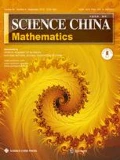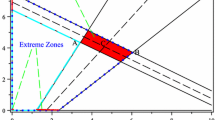Abstract
In this paper, we present a central cutting plane algorithm for solving convex min-max semi-infinite programming problems. Because the objective function here is non-differentiable, we apply a smoothing technique to the considered problem and develop an algorithm based on the entropy function. It is shown that the global convergence of the proposed algorithm can be obtained under weaker conditions. Some numerical results are presented to show the potential of the proposed algorithm.
Similar content being viewed by others
References
Auslender A, Goberna M A, López M A. Penalty and smoothing methods for convex semi-infinite programming. Math Oper Res, 2009, 34: 303–319
Bandler J W, Liu P C, Tromp H. A nonlinear programming approach to optimal design centering, tolerancing, and tunning. IEEE Trans Circuits Syst, 1976, 23: 155–165
Bertsekas D P. Constrained Optimization and Lagrange Multiplier Methods. New York: Academic Press, 1982
Chen T, Fan M K H. On convex formulation of the floor-plan area minimization problem. In: Proceedings of the International Symposium on Physical Design. Monterey, CA: Academic Press, 1998, 124–128
Elzinga J, Moore T G. A central cutting plane algorithm for the convex programming problem. Math Program, 1975, 8: 134–145
Fang S C, Han J Y, Huang Z H, et al. On the finite termination of an entropy function based smoothing Newton method for vertical linear complementarity problems. J Global Optim, 2005, 33: 369–391
Fang S C, Wu S Y. Solving min-max problems and linear semi-infinite programs. Comput Math Appl, 1996, 32: 87–93
Fang S C, Rajasekera J R, Tsao H S J. Entropy Optimization and Mathematical Programming. Boston-London-Dordrecht: Kluwer Academic Publishers, 1997
Feng Z G, Teo K L, Rehbock V. A smoothing approach for semi-infinite programming with projected Newton-type algorithm. J Ind Manag Optim, 2009, 5: 141–151
Fiacco A V, Kortanek K O. Semi-Infinite Programming and Applications. Lecture Notes in Economics and Mathematical Systems. Berlin: Springer, 1983
Goberna M A, López M A. Linear Semi-Infinite Optimization. New York: Wiley, 1998
Gribik P R. A central cutting plane algorithm for semi-infinite programming problems. In: Hettich R, ed. Semi-Infinite Programming, Lecture Notes in Control and Information Sciences 15. New York: Springer-Verlag, 1979, 213–232
Hettich R, Kortanek K O. Semi-infinite programming: Theorey, methods and applications. SIAM Rev, 1993, 35: 380–429
Kassim A A, Vijaya Kumar B V K. Path planning autonomuous robots using neural networks. J Intell Syst, 1997, 7: 33–55
Kortanek K O, No H. A certral cutting plane algorithm for convex semi-infinite programming problems. SIAM J Optim, 1993, 3: 901–918
Li X. An entropy-based aggregate method for minimax optimization. Eng Optim, 1997, 18: 277–285
Li X, Fang S C. On the entropic regularization method for solving min-max problems with applications. Math Methods Oper Res, 1997, 46: 119–130
Polak E. On the use of consistent approximations in the solution of semi-infinite optimization and optimal control problems. Math Program, 1993, 62: 385–414
Polak E, Royset J O. Algorithms for finite and semi-infinite min-max-min problems using adaptive smoothing techniques. J Optim Theory Appl, 2003, 119: 421–457
Polak E, Royset J O. On the use of augmented Lagrangians in the solution of generalized semi-infinite min-max problems. Comput Optim Appl, 2005, 31: 173–192
Reemsten R, Görner S. Numerical methods for semi-infinite programming: A survey. In: Reemsten R, Rückmann J, eds. Semi-Infinite Programming. Boston, MA: Kluwer Academic Publishers, 1998, 195-27
Wu S Y, Fang S C. Solving convex programs with infinitely many linear constraints by a relaxed cutting plane method. Comput Math Appl, 1999, 38: 23–34
Xu S. Smoothing method for minimax problems. Comput Optim Appl, 2001, 20: 267–279
Zhang L P, Wu S Y, López M A. A new exchange method for convex semi-infinite programming. SIAM J Optim, 2010, 20: 2959–2977
Author information
Authors and Affiliations
Corresponding authors
Rights and permissions
About this article
Cite this article
Zhang, L., Fang, SC. & Wu, SY. An entropy based central cutting plane algorithm for convex min-max semi-infinite programming problems. Sci. China Math. 56, 201–211 (2013). https://doi.org/10.1007/s11425-012-4502-z
Received:
Accepted:
Published:
Issue Date:
DOI: https://doi.org/10.1007/s11425-012-4502-z




